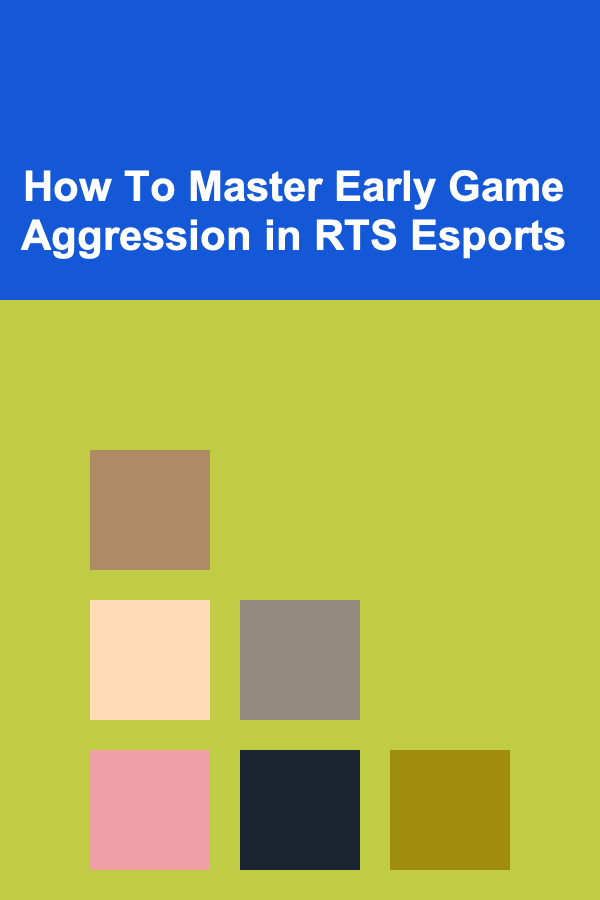
How To Master Early Game Aggression in RTS Esports
ebook include PDF & Audio bundle (Micro Guide)
$12.99$7.99
Limited Time Offer! Order within the next:

Real-Time Strategy (RTS) games have been an integral part of esports for decades. They require players to balance resource management, strategic planning, and tactical execution, all while responding to rapidly changing in-game situations. One of the most exciting and high-stakes phases of RTS matches is the early game, where players often need to decide between playing defensively or executing aggressive strategies. Mastering early game aggression can be a game-changer, and it's a skill that can set you apart in the competitive esports scene.
In this article, we'll explore the core concepts, strategies, and mindset needed to dominate early game aggression in RTS esports. Whether you're a seasoned player looking to refine your tactics or a beginner seeking to understand the fundamental principles, this guide will provide insights into how to leverage early aggression for a tactical edge.
Understanding Early Game Aggression
Early game aggression in RTS games refers to the period right after the game begins, typically in the first 5 to 10 minutes, depending on the game. This phase is crucial because it sets the tone for the rest of the match. Aggression during this phase is often about making your opponent react to your moves rather than simply reacting to theirs.
Key Features of Early Game Aggression:
- Pressure: The goal is to force your opponent into uncomfortable positions, making it difficult for them to execute their strategies.
- Map Control: Aggressive players often try to establish control over critical areas of the map, such as expansions, key resources, or high ground.
- Economy Disruption: A major aspect of early aggression is attacking your opponent's economy, typically through harassment of workers or damaging expansions.
- High Risk, High Reward: Early game aggression can be risky since you are committing resources and units, leaving you vulnerable to counter-attacks. However, when executed correctly, it can lead to significant advantages that snowball throughout the match.
Key Components of Early Game Aggression
Before diving into specific strategies, it's important to understand the core components that make up early game aggression in RTS games. These components are vital in both setting up and executing aggressive strategies effectively.
2.1. Scouting
Scouting is the first and most important step when preparing to be aggressive in the early game. Without good intel on your opponent's strategy, your aggression could easily be countered, leading to a wasted effort or worse, a disadvantageous position.
- Early Scouting: Send out a worker or scout unit to gather information on the enemy's base layout, tech tree, and unit composition. Pay attention to their resource allocation and the timing of their tech structures. Are they focusing heavily on economy, or are they rushing for military units?
- Continuous Scouting: Early game aggression requires you to maintain map awareness throughout the first few minutes. If your opponent counters your initial aggression, you need to quickly adapt your strategy.
Good scouting allows you to decide whether to intensify your pressure or shift gears and play more defensively. The more you know about your opponent's build order, the better you can time your aggression to hit at the perfect moment.
2.2. Build Orders
A build order is a precise sequence of actions, such as resource gathering and unit production, that helps players achieve specific goals within a set timeframe. In early game aggression, the build order you choose will directly impact your ability to execute an offensive strategy. A solid build order helps you get units out quickly and efficiently without compromising your economy or tech progression.
- Offensive Build Orders: In most RTS games, certain build orders are designed specifically for aggressive early game strategies. For example, rushing for a quick barracks or unit-producing structures enables faster unit production to apply early pressure.
- Timing: The timing of your build order is crucial for early aggression. If you go too early, you might not have enough resources or units to sustain pressure. If you go too late, your opponent may have already established their own defensive setup, making your aggression less effective.
2.3. Unit Composition
Early game aggression depends heavily on selecting the right units to achieve your goals. The composition of units you send to attack your opponent can make or break your strategy.
- Ranged vs. Melee: Ranged units are often more effective for harassing enemy workers or softening up defenses from a distance. On the other hand, melee units can overwhelm buildings and enemy units up close.
- Tiers of Units: It's also important to understand the tiers of units in RTS games. Early-game aggression generally involves low-cost, fast units like infantry, light cavalry, or air units. These units can disrupt your opponent's economy by attacking workers or denying expansion locations.
- Flexibility: While a strong unit composition is essential, it's also important to adapt to your opponent's actions. If your opponent counters your early aggression with an unexpected unit or structure, you may need to pivot to a different strategy.
2.4. Map Control
One of the most critical aspects of early game aggression is map control. A player who controls key areas of the map can harass more effectively, deny expansions, and prepare for future attacks.
- High Ground and Chokepoints: In many RTS games, high ground provides a tactical advantage, as units on higher terrain often have improved vision and attack range. Similarly, chokepoints are narrow paths where your opponent's units can become bottlenecked, making it easier to control and defend against enemy movements.
- Expansions and Resource Denial: By controlling or denying access to expansions, you can cripple your opponent's economy, making it more difficult for them to recover. Early aggression focused on cutting off expansions or attacking worker units can force your opponent into a defensive position.
Common Early Game Aggression Strategies
Now that we've covered the essential components of early aggression, let's delve into some specific strategies that can help you dominate your opponent in the early stages of the match.
3.1. Rushes
A rush is one of the most direct forms of early aggression, where you build up a small army of units as quickly as possible and send them to your opponent's base.
- Zerg Rush (or Equivalent) : In games like StarCraft, a Zerg rush refers to the act of mass-producing a large number of inexpensive units (like Zerglings) and sending them to attack the opponent early. The goal is to overwhelm the opponent before they can mount a significant defense.
- Proxy Rush: In this strategy, players build key structures near their opponent's base, outside their natural expansion areas, to produce units more quickly. By building structures closer to the opponent, the player can surprise them with units that arrive faster than expected.
3.2. Harassment
Harassment refers to attacking small, targeted areas of your opponent's economy, such as workers or resource gathering points. While not as direct as a rush, harassment is highly effective at disrupting your opponent's flow of resources and forcing them to divert attention to defense.
- Worker Harassment: By attacking enemy workers (like drones or SCVs), you can disrupt your opponent's economy, forcing them to pull workers off resource gathering or even losing them entirely.
- Tech Denial: If your opponent is trying to tech up to a specific unit, early harassment can be used to delay or stop the production of that unit, making them vulnerable in later stages of the game.
3.3. Early Pressure with Timing Attacks
A timing attack is an aggressive strategy aimed at attacking your opponent at a specific time, when they are least prepared for it. The key to a successful timing attack is knowing when your opponent's defenses are weakest and taking advantage of that window.
- Timing with Tech Transitions: If you know your opponent is transitioning into a powerful tech unit (e.g., siege tanks or air units), you can launch an attack just before they finish their tech upgrades. This can severely hinder their ability to defend.
- All-In Attacks: In some cases, players will commit all their resources to an early attack, leaving themselves vulnerable if the attack fails. While risky, all-in timing attacks can often catch opponents off guard.
Psychological Aspects of Early Aggression
While the tactical aspects of early aggression are essential, the psychological component cannot be ignored. RTS esports is as much about outthinking your opponent as it is about outplaying them. Early aggression, when executed correctly, puts significant mental pressure on the opponent.
- Mind Games: By constantly changing the intensity of your aggression, you can keep your opponent on edge. A series of small attacks or feints can confuse and disrupt their focus, leading to mistakes and missed opportunities.
- Tempo Control: Early aggression helps you dictate the tempo of the game. If you're constantly pressuring your opponent, they'll be forced to play reactively, giving you more freedom to dictate your plans.
Mistakes to Avoid in Early Game Aggression
While aggression can be a powerful tool, it's important to understand the potential pitfalls. Below are some common mistakes that players make when attempting early game aggression.
5.1. Overcommitting
One of the biggest risks of early aggression is overcommitting resources to the attack. If you send too many units or invest too much in an early rush, you may leave yourself vulnerable to counter-attacks.
5.2. Not Scouting Enough
Without proper scouting, you may be executing an aggressive strategy that's ill-suited to your opponent's setup. It's crucial to continuously gather information about their build order, unit composition, and expansion strategy.
5.3. Failing to Adapt
Aggression in RTS isn't a one-size-fits-all solution. Being too rigid in your strategy can lead to failure, especially if your opponent adapts faster than you. The key to successful early aggression is flexibility and the ability to pivot your strategy as needed.
Conclusion
Mastering early game aggression in RTS esports requires a combination of strategic planning, tactical execution, and mental resilience. By scouting effectively, choosing the right build order, and maintaining pressure on your opponent, you can gain a significant advantage in the early stages of the game. However, it's equally important to remain adaptable, continuously scout your opponent's movements, and be prepared to adjust your strategy based on the situation at hand.
By mastering these elements, you can become a formidable player in any RTS game and take your esports career to the next level.

How to Choose Eco-Friendly Lighting for a Sustainable Home
Read More
How to Clean Your Floors Without Damaging the Surface
Read More
How to Incorporate Your Family Traditions into Your Holiday Decor
Read More
How to Sell Your Old Video Games on eBay: An Actionable Guide
Read More
How to Use Stackable Bins for Maximum Drawer Space
Read More
Mastering the Skies: Advanced Wingsuit Flying
Read MoreOther Products

How to Choose Eco-Friendly Lighting for a Sustainable Home
Read More
How to Clean Your Floors Without Damaging the Surface
Read More
How to Incorporate Your Family Traditions into Your Holiday Decor
Read More
How to Sell Your Old Video Games on eBay: An Actionable Guide
Read More
How to Use Stackable Bins for Maximum Drawer Space
Read More